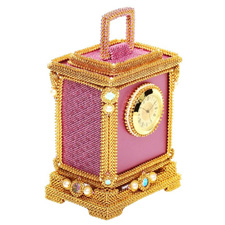|
Description: |
By the early 19th century, the importance of being able to
tell the time, no matter where you were, became vogue among
wealthy travelers. The development of the carriage clock was
designed to meet the need for a portable timepiece. These
diminutive French time pieces were individually made to
order, so there was a wide variety of decorative variations
and movements.
This style of clock making was
still in the experimental stages due to the development of
these special movements. Carriage clocks needed to be able
to be moved, so many of the early designs had mechanical
flaws. But, by the mid 19th century, many of these problems
were solved. Some even had calendars and alarms! Most of the
clocks had sturdy carrying cases designed for travel.
Beadwork & Metal 2: Somewhere in Time was inspired
by the “gorge” case style of carriage clocks. Most were only
about 4 inches tall. Gorge, meaning a steep valley or
canyon, refers to the intricate mouldings on the cases.
These clocks were made primarily with rectangular cases that
had stair stepped bases and flat fitted feet. Moulding
continued up all sides ending with a moulded top and a
shaped handle.
This design is created in parts; the
stair stepped base, the clock case floor and walls, ending
with the lid and handle. The quartz clock is fully
operational and is compression fit into the beaded frame so
that the time can be set and the battery can be changed.
If you are taking Beadwork & Metal for the first time
please click
here
for more information as you will be making the Triangle box
from Beadwork & Metal I and will be paying the kit fee for
the supplies for the boxes.You will recieve the information
to make the clock, too.
|


